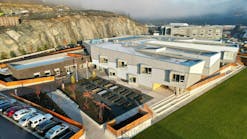Nirvana, by simple definition is “An ideal condition of rest, harmony, stability, or joy.”
You may be saying, “How can such a bold statement be made regarding the operation of an inanimate object?” Simple, it’s not one! A building is really very dynamic and complex in nature, constantly responding to its ever changing internal and external environments.
So why retro-commissioning? Why not “just commission “it? I guess to understand that, we first need to understand commissioning (CX), and the various types, at its very core.
New building CX strives to assure a building operates as the design team envisioned, based on the operating guidelines put forth by the owner, on its intended use and operation.
Re-commissioning basically tunes up the building, so it is operating as the “initial” envisioned design intended, with no changes.
Retro-Commissioning (RCX) holistically looks at the building as it actually operates day to day in the “real world” ----not the theoretical assumed one on how it would! RCX is where energy management and commissioning join forces to improve a facilities operation, or where a ASHRAE Level 2 Energy Audit comes to fulfill its destiny! So how do you get started or better yet how do I get there from here?
Re-commissioning basically tunes up the building, so it is operating as the “initial” envisioned design intended, with no changes.
We are going to start with the basic premise that an Owner already believes his or her building requires to be retro commissioned. The diagram below outlines the five basic phases and subsequent steps to follow for this process to be successful.1. Planning Phase (Pre-Site Visit)
- Review existing building design documents
- Benchmark building
- Develop RCX Plan
- Request Building Management System (BMS) Trending of equipment (If Applicable)
- Conduct stakeholder (Owner, Occupants, maintenance staff, etc.…) interviews.
2. Investigation Phase (Site Visit)
- Perform ASHRAE Level 2 energy audit
- Access building envelope and its major systems
- Equipment diagnostic testing (if deemed required)
- Determine major systems condition, operation, remaining useful life & energy health.
3. Analysis Phase (Building Optimization)
- Evaluate all findings
- Perform a calibrated energy model on building
- Review BMS trends
- Develop all the Energy Conservation Measures (ECM)
- Review with client
4. Implementation Phase (Operational Improvements)
- Prepare ECM documents
- Implement scope
- Retro-Commission Systems
- Verify Results
5. Verification Phase
- Prepare Final Summary Report
- Develop a systems manual
- Develop a Re-Commissioning Plan
- If owner desires develop a Measurement & Verification (M&V) plan
- Develop Persistence of savings strategies.
The 5th and final phase (Verification Phase) is where all the planning, hard work and the visioning come together. This is where all the owner approved ECM have been implemented, tested, and fully commissioned. The implemented ECM could include a plethora of varying scope tasks like replacement of some major equipment for energy efficiency reasons or adding new seals to the windows. However, more than likely, the modifications are more operational in nature, requiring BMS control language modifications to control sequences, along with system verification and tune up (IE: Testing and balancing).This is where the hired team shines, putting the systems and new sequence modifications thru their paces and don’t stop until they all are operating in harmony.
Finally, how to pick the leader for this band? You might be thinking should it be a commissioning agent, or should it be an energy manager? I’m here to tell you, in my opinion for it to be successful, you really need both (along with a good testing and balancing agency partner).
You might be asking why “BOTH”, it’s a commissioning task? What needs to be understood, this endeavor requires the knowledge base, expertise, and skillsets that each one provides. Occasionally, the purple unicorn does exist, and they are one in the same person, but often times they come as a team! The commissioning agent is the “nuts and bolts” person who can make the operational harmony happen. Whereas the energy manager brings building system analytics capabilities, energy simulation modeling and analysis along with utility rate structure understanding.
It’s my humble opinion, when you are going to market to hire the right firm for this, I suggest the following path be followed.
- Send out as a Request for Qualifications (RFQ)--- DON’T PICK BASED ON MONEY
- The energy manager and the commissioning agent are from the same firm or are same person
- The firm has a reasonable track record for this type of work
- Request to assemble a complete team including:
- Engineer to prepare plans, if needed (unless directed otherwise)
- Test and balance agency
- Building’s Automation Controls contractor.
Following the patch as described above will lead you to a successful project that are better for the client, the employees and the environment.
Al LaPera is a certified Commissioning Authority (CxA) from the AABC Commissioning Group (ACG).








